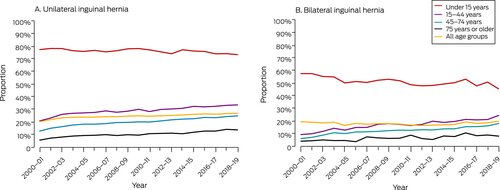
Less than a quarter of inguinal hernia repairs done in Australia are same-day procedures despite the Royal Australian College of Surgeons (RACS) setting a 70–80% target in 2017, according to research published today by the Medical Journal of Australia.
Same-day inguinal hernia repair was recognized as safe and effective 65 years ago, say the authors, led by Dr. Joanna Mills, a Ph.D. candidate at the University of Sydney’s Northern Clinical School.
To ascertain any change in practice since the 2017 RACS review, Mills and colleagues analyzed hospitalization data for patients with inguinal hernia as the principal diagnosis during the period 1 July 2000 to 30 June 2019.
“The same-day inguinal hernia repair rate rose from 22.4% in 2004–05 to 24.6% in 2017–18,” they reported.
“By way of comparison, it increased in New Zealand from 42.7% to 46.5%, and in the United Kingdom from 45.8% to 67.8%.
“We found that 23.1% of inguinal hernia repair procedures in Australia during 2000–19 were same-day procedures. The recent RACS 70–80% target was realized only for patients under 15 years of age who underwent unilateral repair.”
The benefits of same-day repair include out-of-pocket savings for patients, lower risk of procedure cancelation because of unavailable inpatient beds, lower risk of hospital infections, better patient-rated outcomes, better surgeon outcomes through standardized care, improved patient flow and resource allocation, and reduced cost to the health care system.
Mills and colleagues listed some perceived barriers to same-day repair as:
- Patient preferences for overnight stays;
- Surgeon preferences for overnight stays;
- Late scheduling on theater lists;
- Distances between patient home and hospital;
- Inadequate outpatient or primary care support;
- Lack of adequate social support;
- Private hospital-insurer financial arrangements; and,
- Lack of access to an appropriate day surgery facility.
“Patient-reported outcomes following same-day surgery are at least as good as those after overnight stays, but other factors may be barriers to routinely providing this option,” they concluded.
Source: Read Full Article
